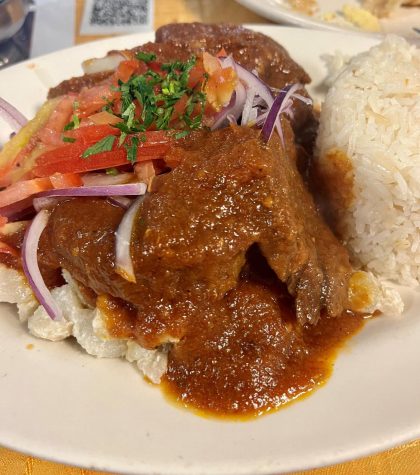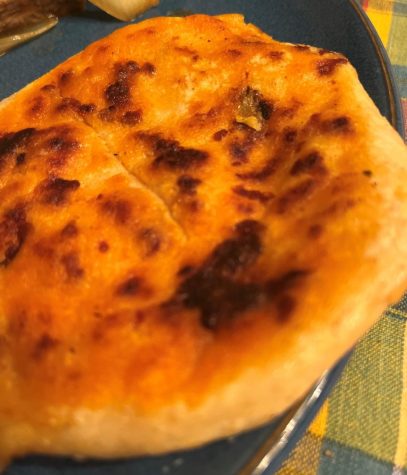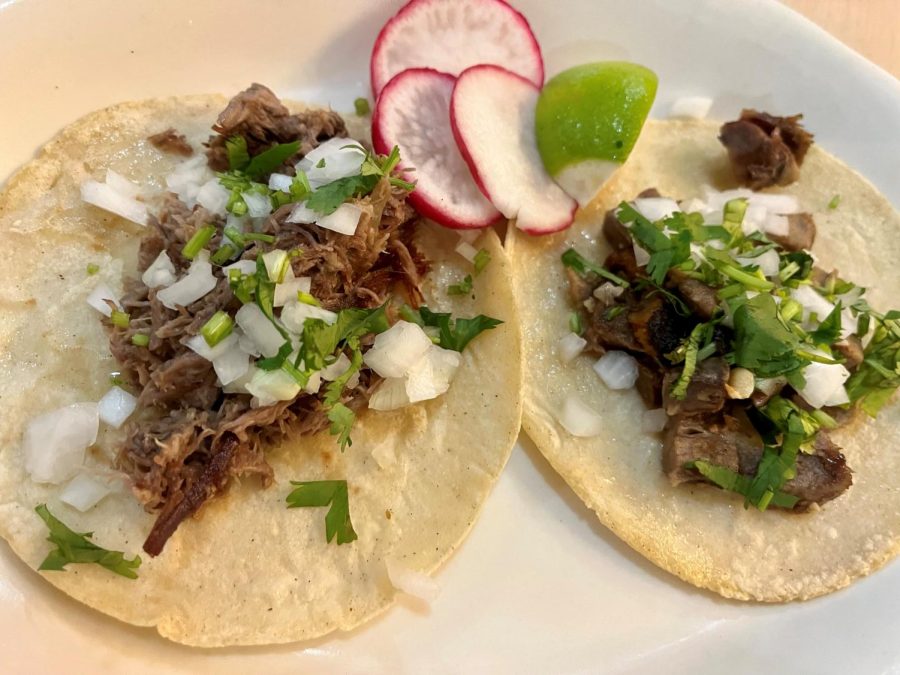Es hora de comer: a taste of Hispanic Heritage Month in the DMV
Pictured: Taqueria Habanero’s taco de lengua (right) and taco barbacoa (left).
October 10, 2022
Each year from Sept. 15 to Oct. 15, we celebrate the influence and contributions of generations of Hispanic-Americans through Hispanic Heritage Month. Throughout the month, various festivals, concerts and performances showcase Hispanic culture around D.C. As a Bolivian-American, my Hispanic heritage is celebrated best through food, a language I am fluent in. Simmering up authentic recipes and enjoying them alongside family provides an essential connection throughout various cultures, including Hispanic culture. With a desire to explore Hispanic cuisine this heritage month, I set off to explore local, Hispanic-owned restaurants in the DMV.
#1. Taqueria Habanero (Mexican)
15 years ago, Mirna and Dio Montero immigrated to the United States from Puebla, Mexico. Starting as dishwashers and line cooks, the Monteros worked tirelessly, hustling between different jobs in the industry before saving enough money to open their own restaurant. After seven years in the United States, the Monteros opened Taqueria Habanero in 2014, located on 14th Street in Northwest D.C. From chapulines — grasshoppers, imported from Oaxaca, Mexico — to the recently trending birria tacos, Taqueria Habanero consistently serves authentic Mexican cuisine.
As I walked into the restaurant, the Monteros’ vision of creating community through a shared love of tacos and margaritas came to life. Mexican flags are proudly draped across the restaurant, and traditional calavera skulls — colorful skulls used in the Mexican celebration of the Day of the Dead — decorated the tables. A crowd of regulars who line the bar in soccer jerseys, attentively watching a match on the TV above, especially brought a sense of community to my meal.
A complimentary basket of freshly fried chips with spicy salsa arrived to begin the meal. Upon ordering, ten minutes flew by before my barbacoa and lengua — beef tongue — tacos were in front of me, waiting to be devoured. Barbacoa is a traditional Mexican shredded meat dish made with beef, goat or lamb and seasoned with dried red chillies. Slow-cooked goat meat filled my fresh corn tortilla taco, topped with a sprinkle of cilantro and chopped white onion. Peppery seasoning and smoky spice from the chili-infused braised goat made for a beautifully savory taco.
Following was the lengua taco, which I selected based on the waitress’ recommendation. Like every taco on the menu, the beef tongue was topped with cilantro, onion and a quarter lime slice on the side. The lengua had a unique, slightly bumpy texture and was one of the most soft, tender meats I’d ever eaten. Although the meat itself was delectable, the dish’s conspicuous lack of sauce — a staple addition of flavor to the traditional dish — gave it an unbearable dryness that required me to take matters into my own hands. By pouring the spicy salsa at the table onto the taco, I added a much-needed punch to the taco. Ordering more tacos throughout the meal is a standard at Taqueria Habanero, so I comfortably ordered some new tacos to savor.
Next arrived an order of birria, which comes with three tacos, along with the octopus taco, a house favorite according to the waitress. Birria is a stew made from a combination of chili pepper-based goat meat adobo, garlic, cumin, bay leaves and thyme, cooked for a long period at a low heat. Tortillas were dipped in the slow-cooked birria beef juice, seared on a grill and finished with melted cheese inside. Adhering to the traditional mode of birria consumption, I drenched each bite in a side of beef consomme, the sauce that the meat cooked in. The tortilla was crisp, the stewed, shredded beef was hearty and the salty Oaxcan cheese dripped out from the sides.
Drizzled with a spicy mayo aioli, topped with purple pickled cabbage and sprinkled with cilantro, the octopus taco was vibrant. The soft, grilled octopus beautifully combined with the acidity of the pickled cabbage and tang from the spicy mayo, making the list of the top three best tacos I have ever eaten. Whether you enjoy fresh seafood or spicy beef, there’s a taco to satisfy all cravings at Taqueria Habanero. Regardless of your selection, admirable service is guaranteed through casual conversation and thoughtful recommendations. Friendly faces, comforting ambiance and delicious Mexican cuisine made the Monteros’ Taqueria Habanero a must-dine experience.
#2. Luzmila’s Bolivian Restaurant (Bolivian)
The DMV is home to the largest population of Bolivians in the country, my family and I among them. While personal experience dictates that home-cooked Bolivian meals typically surpass their restaurant counterparts, Hispanic Heritage Month proved a fitting occasion to venture outside my own kitchen and explore local Bolivian cuisine. Just 20 minutes away from downtown Bethesda lies Luzmila’s Bolivian Restaurant, my destination for a Sunday lunch.

As I stepped through the small door and into the cozy restaurant, cheerful sounds of traditional Bolivian music and the sight of the accompanying dances emanated from the TV, transporting me to the bustling restaurants in Bolivia that I frequented when visiting relatives. Luzmila’s was filled with families talking loudly and enjoying their Sundays together. The menu contained a handful of traditional dishes I grew up eating at home and with relatives. I immediately knew what to order: picante de lengua — spicy beef tongue — one of my favorite dishes. Before the main course arrived, I ordered a pastel — a fried, cheese filled pastry. The pastry arrived with a tin of powdered sugar, and after generously dousing the pastel in sugar, I savored the sweet, crunchy bites, a salty kickback soon seeping into my taste buds from the melted cheese that rested inside. Topping it with more powdered sugar after each bite, the savory pastry surprisingly outshined the ones I remember eating in Bolivia. As I nibbled on my appetizer, servers carrying sizzling plates of asado — seared steak — constantly passed my table, enticing my senses and building anticipation.
The picante de lengua arrived shortly after, looking remarkable. The beef tongue was lathered in what the menu describes as “the Bolivian sauce” — a spicy blended tomato and onion-based sauce — and rested atop a bed of chuño, a traditional, chewy and dry Bolivian potato dish. The order came with a mountain of white rice on the side. I took care to capture each bite with a little bit of everything, and pure happiness erupted in my mouth. The “Bolivian Sauce” was subtle and only slightly spicy, pairing perfectly with the tender pieces of beef. Slices of onions cooked together with the rice gave flavor to the seemingly bland side dish.
Regulars joked with the waiters, families laughed among their loved ones and conversations in Spanish filled the small, intimate eatery. Dining among Bolivian families and eating delicious, traditional Bolivian food outside of the country and my home was a positive, new experience for me. Conversing in Spanish with my brother, the waiter and friendly diners throughout my meal connected me to my roots and inspired me to make lunch at Luzmila’s Bolivian Restaurant a monthly outing.
#3. Pupuseria Mama Emila (El Salvadoran)

El Salvadorans make up the largest Latino group in the DMV with over 208,000 Salvadoran immigrants living in D.C., Baltimore and MD areas alone. A Google search for “Salvadoran food” produces numerous results. Among them lies Pupuseria Mama Emilia, an easy 17 minute drive from Whitman. Owner Elsy Claros grew up in Cojutepeque, El Salvador, eating her mother’s homemade pupusas and selling them at a local market. The thick, round flatbreads are traditionally stuffed with cheese and meat, and are the national dish of El Salvador. When Claros immigrated to the United States in 1997, she knew she wanted to make and sell pupusas, just like her mom had. It wasn’t long before Carlos and her daughter Ericka opened their first location in Beltsville, named after Carlos’ late mother, and recently expanded to a second location in Rockville. The restaurant is already a hotspot among locals.
Sizzling sounds from the eatery’s kitchen invited me into its small dining space containing around ten tables. Windows are painted onto the walls with bright lights hung across, meant to imitate the streets of Cojutepeque, El Salvador. A long list of homemade, cornmeal pupusas awaited selection. After ordering the three traditional options of beef, chicken and spinach pupusas, my hunger grew at the sight of fluffy, pillow-like pupusas cycling around the restaurant. Picking up the pupusa was like holding a cloud of comfort in my hands, and biting into it spread the feeling of warmth to my taste buds. In the beef pupusa, a layer of slow-cooked shredded beef sat upon a layer of melted cheese, wrapped in the cornmeal dough. The pupusa dough has a one-of-a-kind flavor, with powerful hints of corn and a chewy texture. The chicken and spinach pupusas were satisfactory, but the beef pupusa left me with a particularly rich, chili flavor. Overall, Mama Emilia granted me the perfect introduction to Salvadoran food, and the cozy, family-oriented restaurant created the same ambiance of the intimate eateries one might find in Cojutepeque.










Diya • Oct 11, 2022 at 9:01 am
Wonderful article! I would love to get to know the student who wrote this masterpiece.
Susana Escobar • Oct 10, 2022 at 10:23 pm
Excellent note with good suggestions. Great way to celebrate Hispanic Heritage Month!